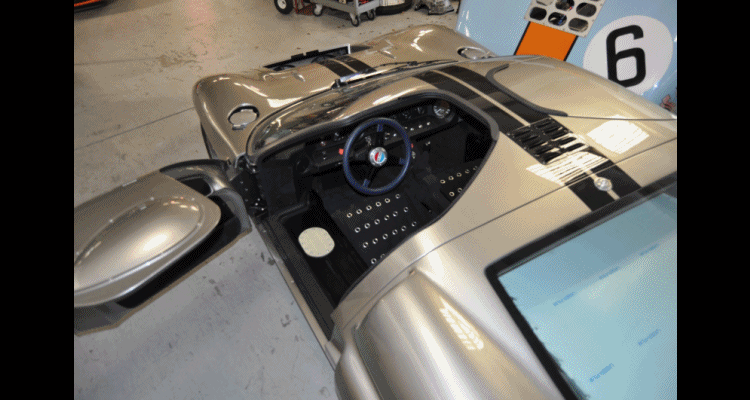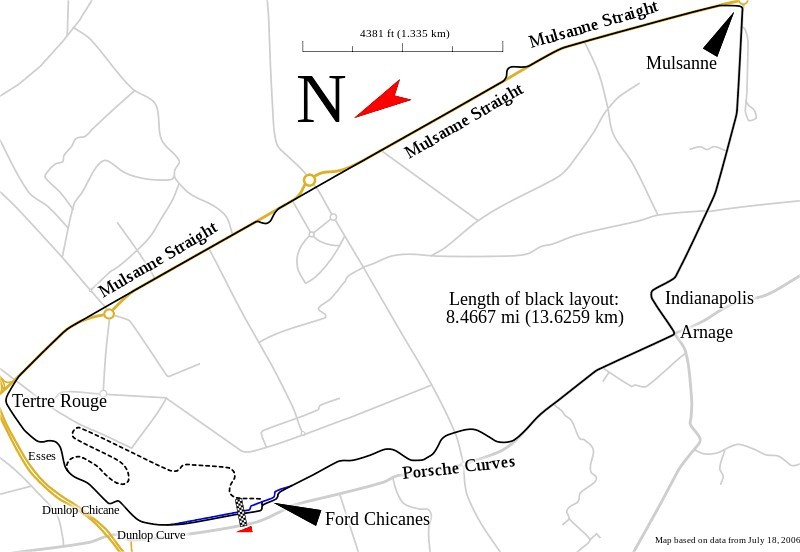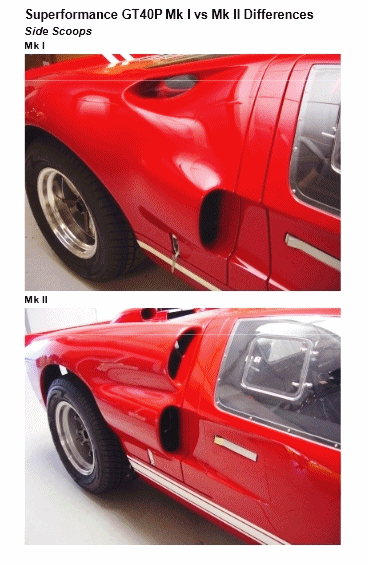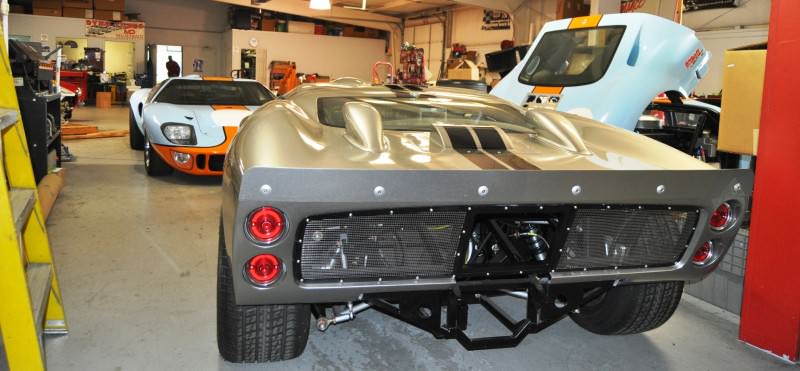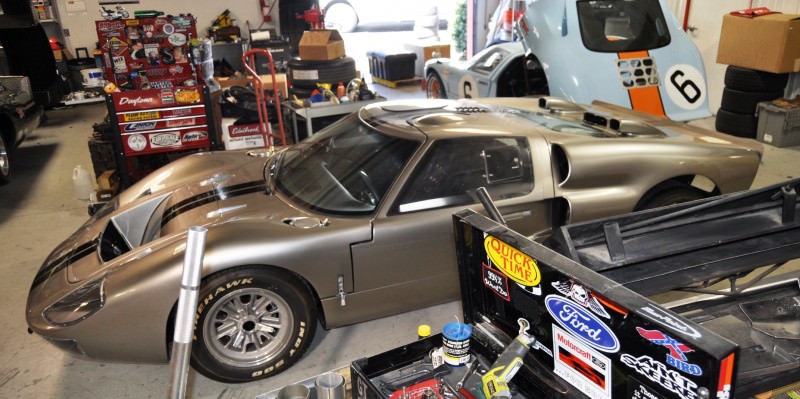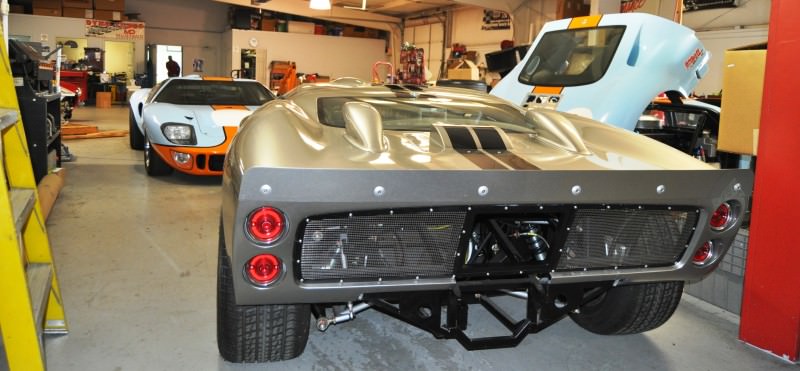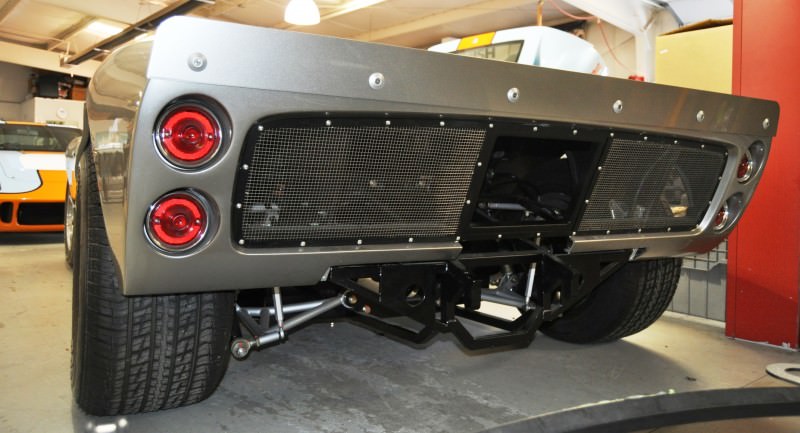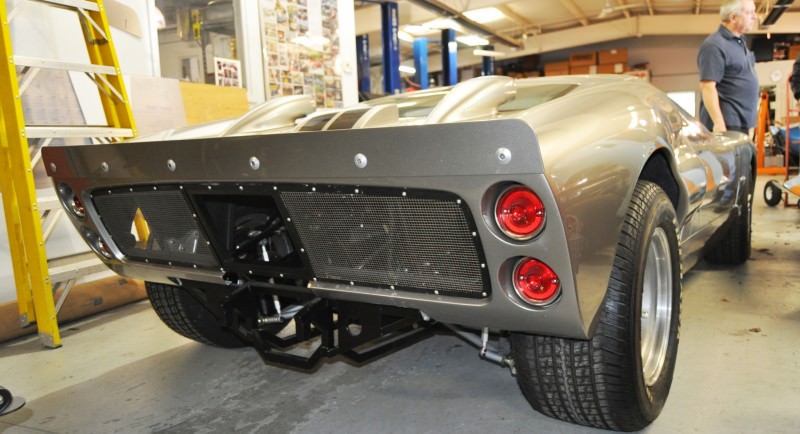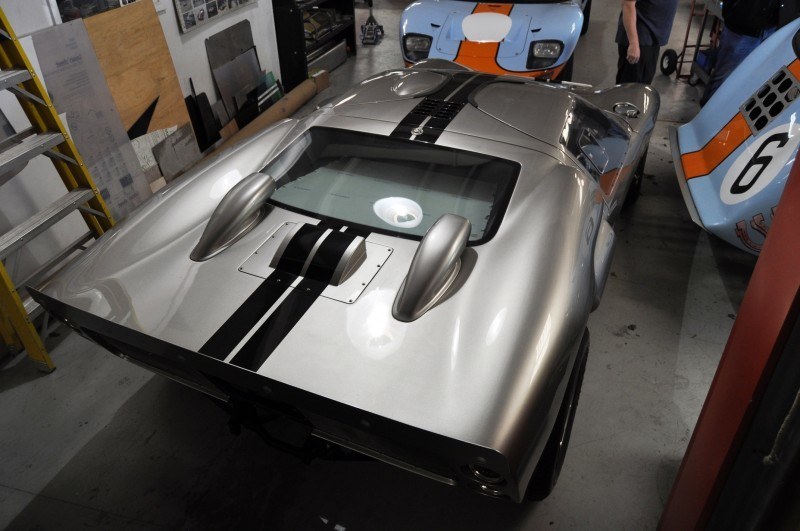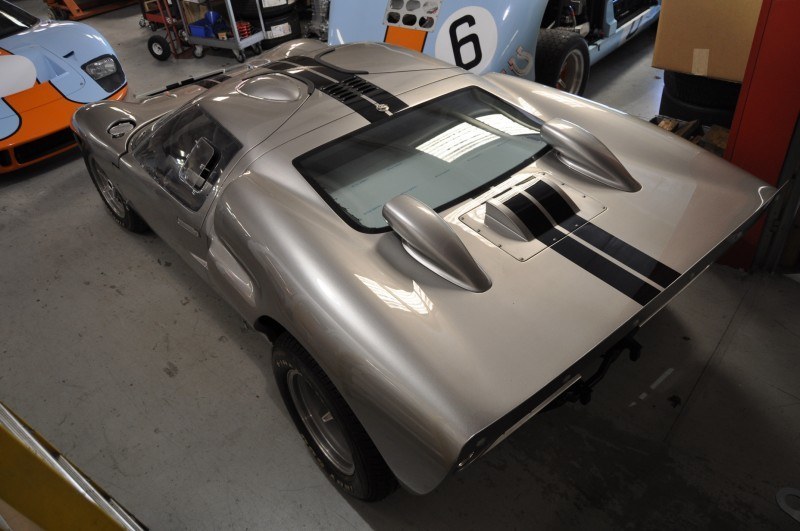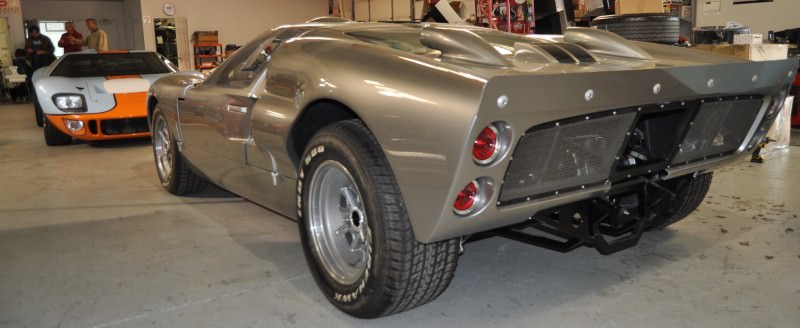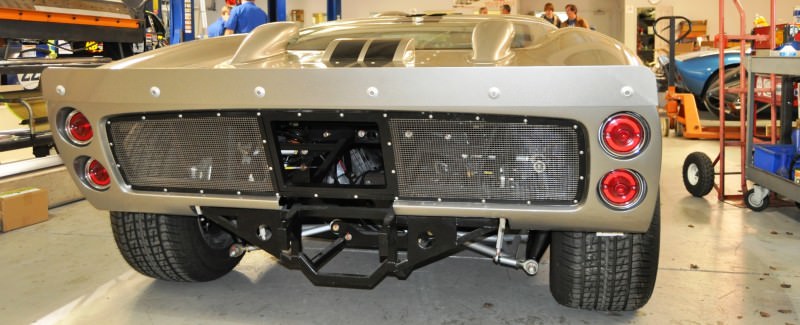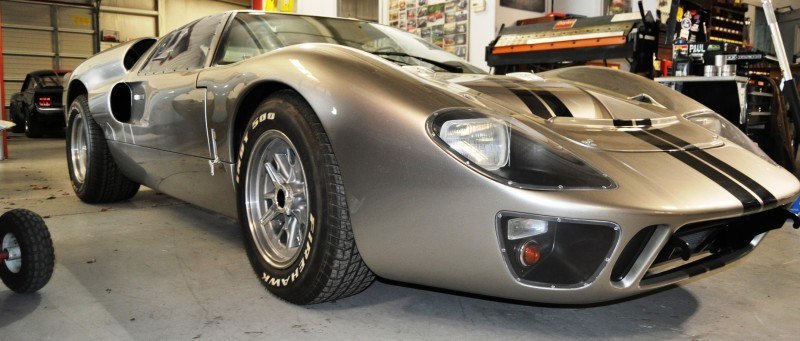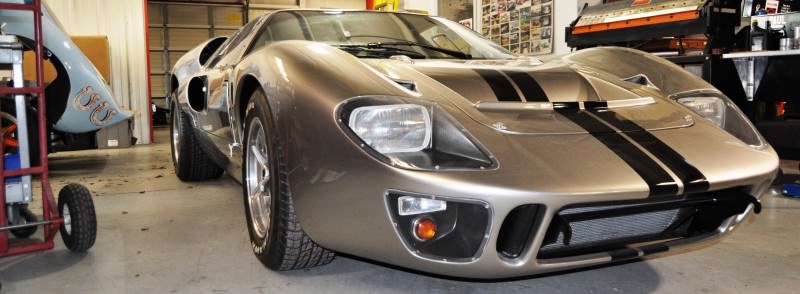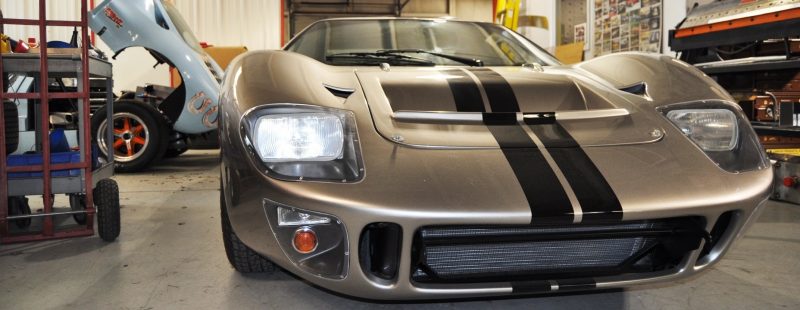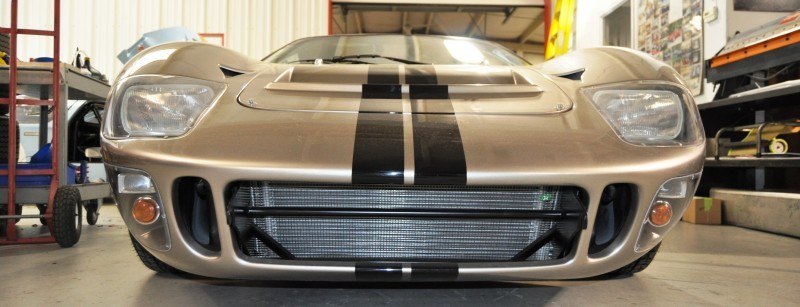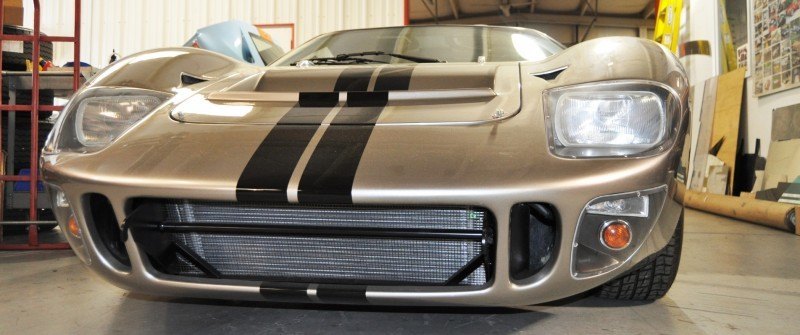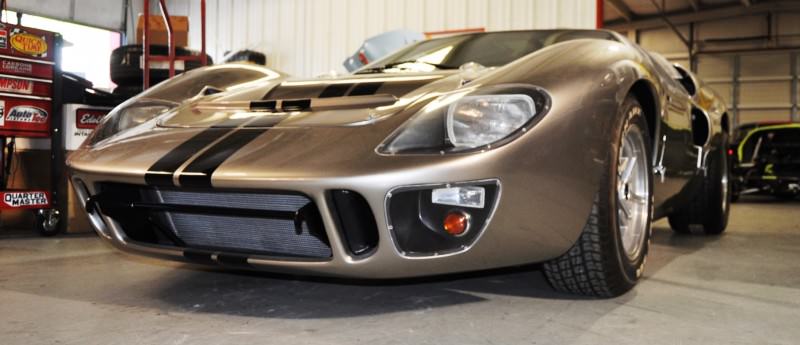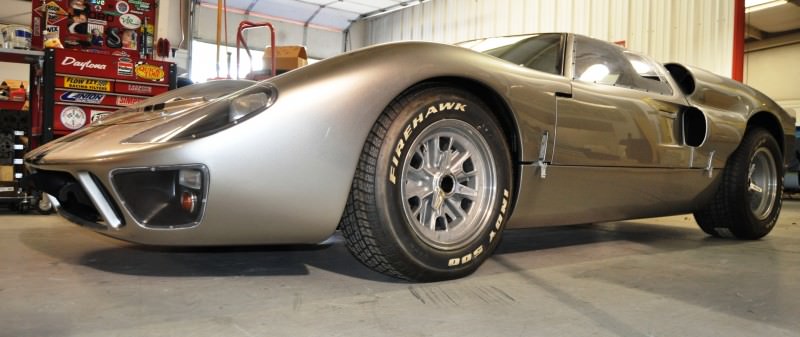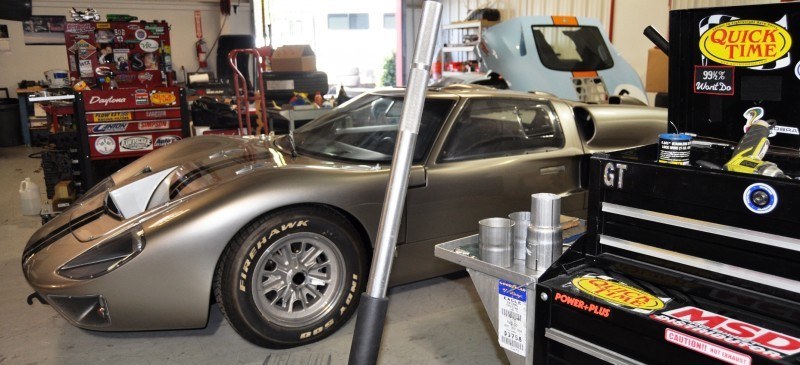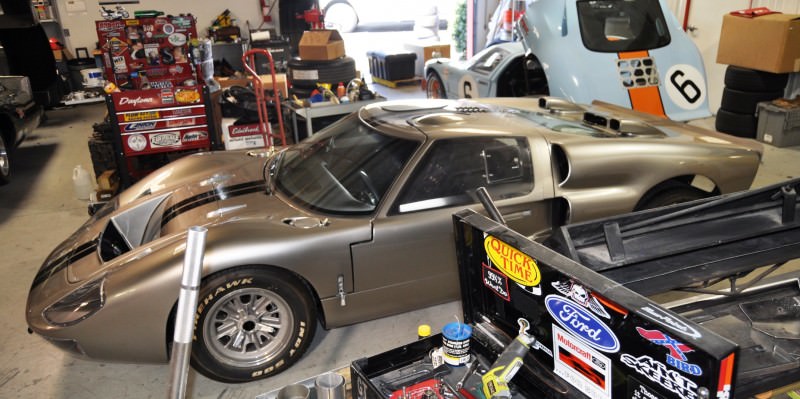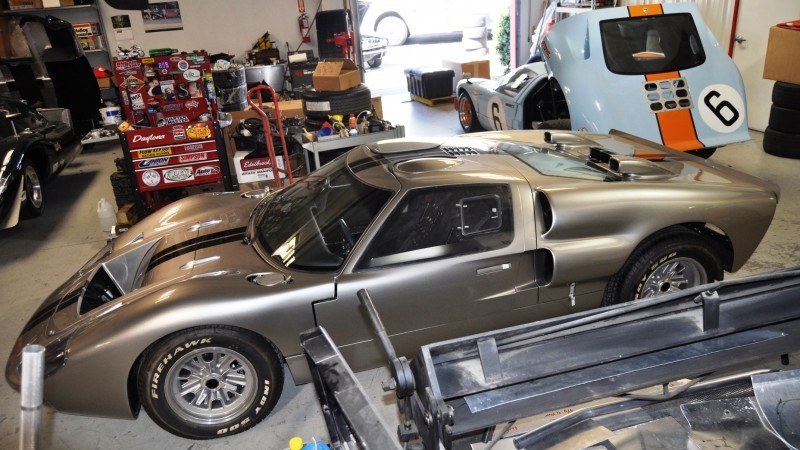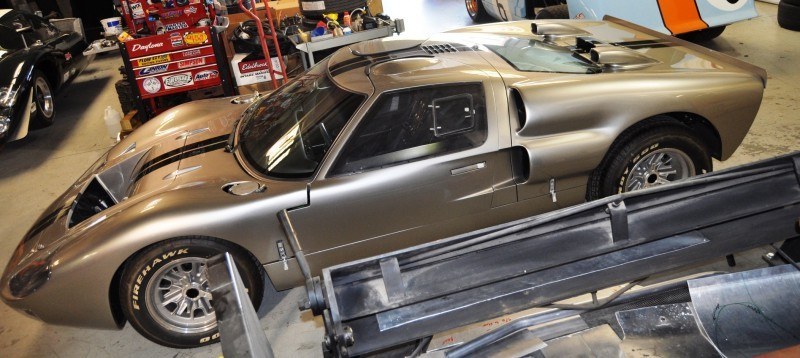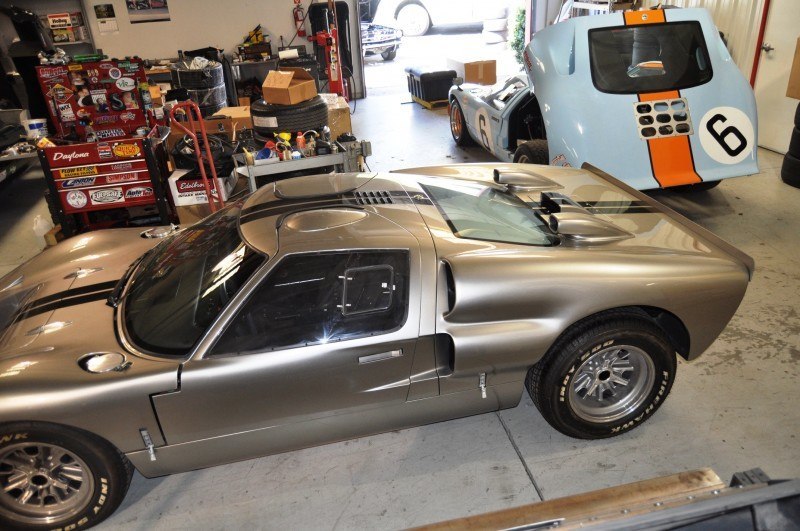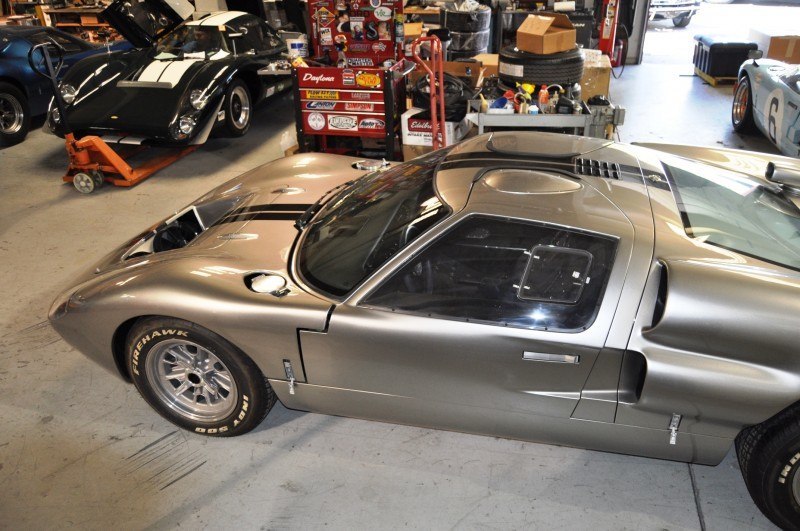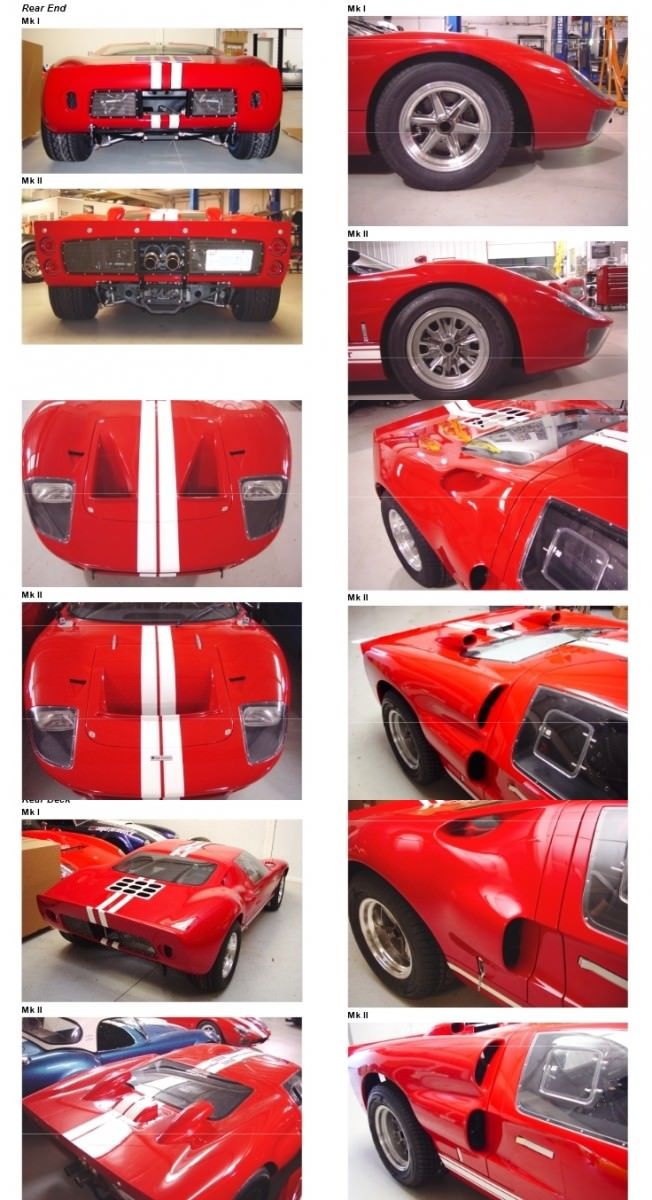Is there beauty in functionality? That is the question to ask when debating a GT40 Mark I versus its successor, the GT40 Mark II.
Is authenticity of the actual 1-2-3 1966 7.0-liter Mark II race win better than the clean lines and simple aesthetic of the Mark I — which was actually a trouble-prone testing bed for the losing 1964 and 1965 seasons?
The 24 Hours of LeMans is widely known as the most grueling durability and endurance test ever fathomed, let alone run annually with a field of more than sixty cars across four racing categories: LMP1, LMP2, GT2 and GT3.
Similar classes of varying pace were always a LeMans hallmark. It is not only a test of the cars – but the pit crews, the drivers, and a test of man versus nature at its core. Could a single machine be driven flat-out at speeds topping 240MPH down the Mulsanne Straight, then down to 15MPH by the Tertre Rouge at the end of this huge flat-out section. No chicanes at this point, so the yellow line below is accurate for 1966.
What does Tertre Rouge translate to in a English? Red Mound. As in: blood red hill if your brakes failed or faded.
Designing a car that could do both things meant it had to be reliable, devastatingly-fast, and relatively drive-able. All GT40’s were many things, but manageable at low speeds was not really one of those traits. Straight-line pace was the core competency, with brakes and transmissions and cabins all cooled most effectively via ram-air effect of huge wind as high speeds.
From the inception of Ford Advanced Vehicles in 1963, the team learned quickly about what would work against this, the most prestigious endurance race in the world. The Shelby excelled on small tracks. It was too short and too darty at super-Vmax speeds to be a serious contender in the LMP1 class.
The GT40 was the marquee achievement in 1964, but did not snatch its first victory from under Ferrari’s nose until 1966.
Simultaneous development of the GT40 Mark II began almost as soon as the first-gen GT40s started testing in 1964.
Larger and more-brutish aero scoops and spats were mandatory to keep everything cool — including the drivers — huge revisions to the overall suspension and brakes meant these new cooling channels were now ducted to exactly where the cool air was needed, versus just shunted in for the first GT40.
The result is the GT40 Mark II, faithfully and authentically recreated today by Superformance with the blessing of the Ford Racing Safir Spares organization.
Any current updates simply continue the evolution of this purposeful design – air conditioning, better-quality and stronger steels, lighter weights and more gear ratios.
Visiting Olthoff Racing in North Carolina was a dream-come-true for a car and history fanatic like myself, and I snapped 350 photos in under an hour. That is not exactly LeMans pace, but I will do better on my own Mark II evolution — harder, lighter, faster, stronger.
Just like the Superformance GT40 Mark II – which would go on to win for not just 1966, but 1967, 1968 and 1969 on the trot.
As the specs and official details show below, the only major changes versus the racecars are all enhancements. But the Superformance’s standard Air Conditioning would be the most-admired feature among drivers of the 1966-1969 LeMans dominance by the Mark II GT40.
Reliving these glories is fine in print, but from about $150,000 — Superformance and Olthoff Racing will build you a street-legal example that can be driven to work every day.
Trust me, the cars in the flesh and firing on all cylinders leave quite the impression – in a way that old film reels and even this article surely cannot.
TECH SPECS
| GENERAL SPECS | 1966 Ford GT 40 Mk IIA Le Mans Winner |
Superformance GT Mk II |
|||
| Weight, lb | 2682 | 2400 | |||
| Weight Distribution front/rear, % |
38/62 | 40/60 | |||
| Wheelbase in. | 95.0 | 95.0 | |||
| Track front/rear, in. | 57/56 | 56/59 | |||
| Overall length, in. | 163.0 | 163.0 | |||
| Overall width, in. (over scoops) |
70.0 | 70.5 | |||
| Height, in. | 40.5 | 39.5 – 40.5 | |||
| Frontal area, sq. ft. | 15.8 | 15.8 | |||
| Fuel tank capacity, gal. | 42 | 22.5 | |||
| ENGINE SPECS | |||||
| Family | Ford FE | Ford 351W | |||
| N. cyl. & type | V8 | V8 | |||
| Bore x stroke, in. | 4.232 x 3.784 | 4.125 x 4.000 | |||
| Displacement, cu. in. | 427 | 427 | |||
| Compression ratio | 10.5 | 10.25 | |||
| Bhp @ rpm | 485 @ 6200 | 550 @ 5600 | |||
| Torque @ rpm, lb. ft. | 475 @ 4000 | 535 @ 5200 | |||
| Carburation | 1 x 4 bbl | 1 x 4 bbl, or EFI | |||
| DRIVE TRAIN | |||||
| Transaxle | Ford T-44 | RBT | |||
| Speeds | 4 | 5 | |||
| Gear ratios, transmission/overall |
|||||
| 1st | 2.22 / 6/18 | 2.58 / 9.73 | |||
| 2nd | 1.43 / 3.96 | 1.61 / 6.07 | |||
| 3rd | 1.19 / 3.30 | 1.14 / 4.30 | |||
| 4th | 1.00 / 2.77 | 0.846 / 3.19 | |||
| 5th | 0.642 / 2.42 | ||||
| Differential ratio | 3.09 | 3.77 | |||
| Transfer gear ratio | 0.899 | ||||
| AERODYNAMICS | |||||
| Frontal area | 14.1 sq ft | 14.1 sq ft | |||
| Drag coefficient (Cd) | 0.39 | 0.39 | |||
| Drag area (Cd*A) | 5.50 | 5.50 | |||
| CHASSIS & SUSPENSION | |||||
| Frame type | Semi-monocoque, sheet steel |
Semi-monocoque, sheet steel |
|||
| Brake type | Vented disc, single caliper | Vented disc, single caliper | |||
| TIRES | Goodyear “A” | Yokohama Avid | |||
| Front tires | 9.75 – 15 (250 / 60-15 approx) |
225 / 60R15 (test) 225 / 50R15 (opt) |
|||
| Rear tires | 12.8 – 15 (325 / 60-15 approx) |
275 / 60R15 (test) 295 / 50R15 (opt) |
|||
| WHEELS | |||||
| Front wheels | 15 x 8 | ||||
| Rear Wheels | 15 x 10 | ||||
| Steering type | Rack and pinion | Rack and pinion | |||
| Front suspension | Independent with unequal length A-arms, coil springs, tube shocks, anti-roll bar | Independent with unequal length A-arms, coil springs, tube shocks, anti-roll bar | |||
| Rear suspension | Independent with trailing arms, unequal length lateral arms, coil springs, tube shocks, anti-roll bar | Independent with trailing arms, unequal length lateral arms, coil springs, tube shocks, anti-roll bar | |||
| INSTRUMENTATION | |||||
| Instruments | 7000 rpm tach oil temperature water temperature fuel pressure ammeter gearbox oil temperature | oil pressure 8000 rpm tach water temperature oil temperature fuel level ammeter 200 mph speedometer | |||
| Warning lights | differential oil pressure engine oil pressure | high beam alternator turn signal radiator cooling fans | |||
| CALCULATED DATA | |||||
| Engine rpm @ 60mph | 1905 | 1811 | |||
| LB / hp (with driver) | 5.8 | 4.6 | |||
| SPEED IN GEARS mph @ rpm |
|||||
| 1st | 89 @ 6200 | 53 @ 6400 | |||
| 2nd | 140 @ 6200 | 85 @ 6400 | |||
| 3rd | 170 @ 6200 | 120 @ 6400 | |||
| 4th | 205 @ 6200 | 161 @ 6400 | |||
| 5th | 207 @ 6400 | ||||
| ACCELERATION | |||||
| Time to speed | |||||
| 0-40 mph, sec. | 2.8 | 2.1 | |||
| 0-60 mph, sec. | 4.2 | 3.7 | |||
| 0-80 mph, sec. | 5.6 | 4.8 | |||
| 0-100 mph, sec. | 8.2 | 6.9 | |||
| 0-120 mph, sec. | 10.8 | 9.2 | |||
| 0-140 mph, sec. | 14.0 | 11.8 | |||
| 0-160 mph, sec. | 19.1 | 15.3 | |||
| 0-180 mph, sec. | 27.0 | 21.7 | |||
| Time to distance | |||||
| Quarter mile, sec. @ mph. | 12.0 @ 129 | 11.2 @ 135 | |||
| FUEL ECONOMY Steady state mpg in top gear |
|||||
| 70 mph | 16.5 | 16.0 | |||
| 100 mph | 15.7 | 15.1 | |||
| 150 mph | 10.1 | 9.62 | |||
| 200 mph | 6.2 | 5.9 | |||
Notes:1. Data for 1966 Ford GT40 from: Road & Track, Oct 1966, Portrait of the Le Mans Winner, Technical Analysis. 2. Data for Superformance GT40 Mk II from: Dimensions measured from GT 001 Weights from factory data for GT 002. Production drive train ratios from factory data engine specs from Roush data. 3. Superformance GT40’s correct height depends on tire size and settings. 4. Superformance GT40 is lighter, primarily because of a lighter engine. 5. Difference in tread measurement is due primarily to differences in tire sizes. 6. Acceleration and fuel economy data from performance simulator. 7. Ford GT40 initial acceleration hampered by tall first gear. |
|||||
Official Details below from Superformance
GT40 continuation collectible is licensed and endorsed by Safir GT40 Spares LLC, as a true “continuation” of the original. Each hand crafted GT40 carries the GT40 -P chassis number and is registry eligible. The versions that are currently offered are the MK1 or MK11 “A” and “B” body styles, available in right or left hand drive, and have a curb weight of 2400 lbs.
The chassis is an exact replication of the original monococque unibody structure down to the press steel roof spider. The only departure is the use of electro-galvanized sheet steel in the construction. The chassis, at over 12,000 pounds per degree is stiffer than any other chassis on the market, and is made up of over 244 laser cut and bent or pressed parts.
The suspension features the original race car lay out. So original are the GT40 continuation models that two thirds or the parts are interchangeable with an original.
The GT40 continuation accurately replicates the original chassis, suspension, wheel hubs, uprights, pedal box, instruments, steering, dash, “bundle of snakes” headers, catches and latches to name a but a few.
Automobile owners also have the luxury of modern safety modifications such Wilwood super light brakes, Bilstein shocks with H& R springs, an adjustable pedal box, cross flow radiator. Air conditioning which has been added with the compressor unit cleverly disguised in a mock up dry sump placed in the original position.
A center shifter is standard but the continuation GT40 may be ordered with an original style sill shifter available for right hand drive models. IF you have a left hand drive continuation GT40 you may want to opt for a modified sill shifter which is cable driven.
The Continuation GT40 is 163 inches long, 40 inches high with a ground clearance of 4″. The GT40 continuation is 70 inches wide. The track front and rear are both 57 inches with a 95 inch wheelbase. The GT40 continuation has dual “Monza” style gas fillers and a 22.5 gallon fuel tank.
The interior features original style seats and racing 4 point harness seat belts. The GT40 continuation will comfortably fit a 95 percentile driver (6’2″ X 240 lbs) by removing the seat “trampoline” support. A Racing style dash features Smith Gauges. The GT40 continuation has Rack and Pinion steering and has been fitted with a removable steering wheel for easy access to the cockpit.
We offer the following wheel options on the MKI: The standard MK1 BRM style rims are 10″ wide in the rear. Available on special order are the MKI BRM style 8″ rims or the wide body 13″ rims. The spare wheel access cover can be ordered in a single or dual opening type.
The GT40 continuation leaves the factory as complete rolling chassis, complete in every way except for the engine, clutch, and transaxle.
The recommended power source is a specially prepared Roush engine with the new RBT/ZF style 5-speed transaxle but owners also have the option to fit a Ford-based 289, 302, or 351W small block or 427 big block (MKII only) engine.
*Our GT-40 chassis uses ZE 50/50 a Zinc coated mildsteel steel(Electro Galvanized Steel) this ensures that our Chassis stand the test of time against rust and other harmful pollutants.
STANDARD EQUIPMENT
GT40 MKII
|
|
Special Thanks to Superformance and Olthoff Racing!
Brought to you by Superformance LLC
© 2007 Superformance LLC
6 Autry Irvine, CA. 92618
Olthoff Racing
Olthoff Racing
150 Cobra Lane
Mt. Ulla, NC 28125

Tom Burkart is the founder and managing editor of Car-Revs-Daily.com, an innovative and rapidly-expanding automotive news magazine.
He holds a Journalism JBA degree from the University of Wisconsin – Madison. Tom currently resides in Charleston, South Carolina with his two amazing dogs, Drake and Tank.
Mr. Burkart is available for all questions and concerns by email Tom(at)car-revs-daily.com.

